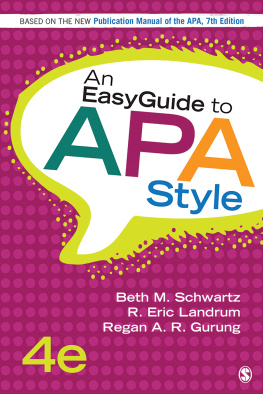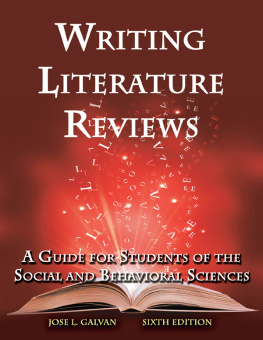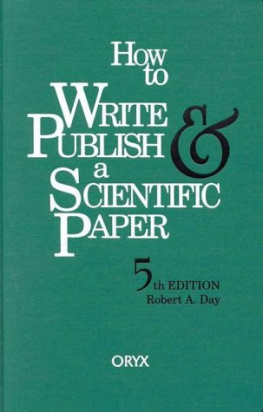
This second edition first published 2012
2012 John Wiley & Sons, Inc.
Edition History: Blackwell Publishing Ltd (1e, 2008)
Wiley-Blackwell is an imprint of John Wiley & Sons, formed by the merger of Wileys global Scientific, Technical and Medical business with Blackwell Publishing.
Registered Office
John Wiley & Sons, Ltd, The Atrium, Southern Gate, Chichester, West Sussex,
PO19 8SQ, UK
Editorial Offices
350 Main Street, Malden, MA 021485020, USA
9600 Garsington Road, Oxford, OX4 2DQ, UK
The Atrium, Southern Gate, Chichester, West Sussex, PO19 8SQ, UK
For details of our global editorial offices, for customer services, and for information about how to apply for permission to reuse the copyright material in this book please see our website at www.wiley.com/wiley-blackwell .
The right of Bernard C. Beins and Agatha M. Beins to be identified as the authors of this work has been asserted in accordance with the UK Copyright, Designs and Patents Act 1988.
All rights reserved. No part of this publication may be reproduced, stored in a retrieval system, or transmitted, in any form or by any means, electronic, mechanical, photocopying, recording or otherwise, except as permitted by the UK Copyright, Designs and Patents Act 1988, without the prior permission of the publisher.
Wiley also publishes its books in a variety of electronic formats. Some content that appears in print may not be available in electronic books.
Designations used by companies to distinguish their products are often claimed as trademarks. All brand names and product names used in this book are trade names, service marks, trademarks or registered trademarks of their respective owners. The publisher is not associated with any product or vendor mentioned in this book. This publication is designed to provide accurate and authoritative information in regard to the subject matter covered. It is sold on the understanding that the publisher is not engaged in rendering professional services. If professional advice or other expert assistance is required, the services of a competent professional should be sought.
Library of Congress Cataloging-in-Publication Data
Beins, Bernard.
Effective writing in psychology : papers, posters, and presentations / Bernard C. Beins,
Agatha M. Beins. 2nd ed.
p. cm.
Includes bibliographical references and index.
ISBN 978-0-470-67124-5 (hardback) ISBN 978-0-470-67244-0 (paperback)
1. PsychologyAuthorship. I. Beins, Agatha, 1976 II. Beins, Agatha M. III. Title.
BF76.7.B45 2012
808.06615dc23
2011046045
A catalogue record for this book is available from the British Library.

Preface to the Second Edition
A writing project is never done. If you are thoughtful about your writing, you will always spot elements in your prose that you think could have been better. Thus writing a book like this one leads to a process, not a product. So, when we wrote the first edition of Effective Writing in Psychology, we recognized that it would be a helpful book with an interesting approach to writing. But there were also a few places where we wondered if we could have made our point more effectively or written more clearly.
So with this edition of Effective Writing we have had the opportunity to do it again, only better. Happily, we think that there were only a few instances in the first edition that needed clarification, expansion, or rewording. But we tried to take care of them to make the book even stronger. We hope you benefit from the changes we made.
In addition, as with any evolving domain, the technical aspects of writing in APA style have changed since the first edition of Effective Writing appeared. So we have adapted the sections on writing in APA style to conform to the sixth edition of the Publication Manual of the American Psychological Association. Many changes to the publication manual are minor, so you will be able to learn and implement them easily.
It has been as delightful working on this edition as it was on the first edition of Effective Writing. A fatherdaughter collaboration is a joy. Our work together constantly reminded us of our mutual respect at the personal and professional levels.
As always, though, a project like this does not happen by accident. It requires collaborative efforts on the part of many people. We are grateful to the professionals at Wiley-Blackwell for their help, in particular Matt Bennett, Nicole Benevenia, and Julia Kirk.

Preface to the First Edition
Mark Twain recognized the importance of effective writing skills when he said, The difference between the right word and the nearly right word is the same as that between lightning and the lightning bug. We wrote this book to help writers generate their own version of lightning when they write papers, create posters, or develop presentations in psychology.
As we have taught courses in writing and in psychology (one of us for over a third of a century), we have become very aware how important it is for students and researchers to develop solid communication skills. No matter what type of professional work you undertake, it will be critical for you to convey your ideas well.
As you write and communicate in psychology, you will face challenges that some other types of writers do not. Writing in psychology involves two separate components. One concerns the ability to create clear and crisp prose that people want to read. The second relates to the ability to convey a compelling message in technical and scientific language. All too often, scientific writers understand their concepts exceedingly well, but they fail to present a message that readers can understand, appreciate, or even want to read. Here this book enters the picture. We present suggestions and guidelines that will help you create interesting papers and cogently delivered oral presentations that will capture the attention of others.
This book will help writers at all levels of experience and skill. Some components of the book are oriented toward effective writing and give tips that are relevant for communicating with many different readerships. Other components provide direction for successful use of writing in American Psychological Association (APA) style. By using both of these aspects of the book, first-time and experienced writers can be comfortable knowing that their words will have an impact and that their work will be recognized as of professional quality.
We have worked to make this book both accessible and useful. At the same time, we have made it rigorous because writing should be as clear and precise as it is interesting.
Organization of the Book
The book begins with an overview of different kinds of writing and what makes writing for psychology different. In addition, we introduce some of the principles for developing credible arguments and effective communication, whether you are writing or speaking, or creating graphic presentations. We also introduce APA style, which is common in many of the behavioral and social sciences.
The book details guidelines on developing your own ideas and conducting Internet and library research to integrate them with issues that others have already addressed. The next focus of the book involves organizing your thoughts and beginning the process of writing and revising.













